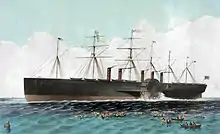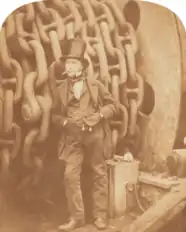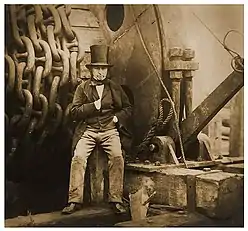Isambard Kingdom Brunel Standing Before the Launching Chains of the Great Eastern
Isambard Kingdom Brunel Standing Before the Launching Chains of the Great Eastern is a photograph taken by Robert Howlett in November 1857. It shows Brunel, the British engineer, during the troubled first attempt to launch the SS Great Eastern, by far the largest ship constructed to that date. Brunel is standing in front of a large drum of chain used to restrain the ship while it was lowered down the launching ramp. Brunel's trousers and boots are muddy from the shipbuilding yard and he is smoking one of his customary cigars. His pose has been described as casual and self-assured. The image has become iconic of the industrial era and the 19th century and has been included in many published collections of photographs. It was widely reproduced at the time of the ship's eventual launch in January 1858 and again after Brunel's death in 1859.
%252C_The_Metropolitan_Museum_of_Art.jpg.webp)
Background

Isambard Kingdom Brunel was a British engineer who constructed a number of innovative civil and railway engineering projects and, in 1845, the SS Great Britain, at that time the largest ship ever built.[1] In 1853 he began construction of the SS Great Eastern, which would be six times larger than any other ship ever constructed.[2] The project would be Brunel's last and one of his most ambitious and frustrating.[3] With the vessel measuring 692 feet (211 m) in length and 22,500 long tons (22,900 t) in weight it proved difficult to launch. Beginning in November 1857 it took three months to launch, sideways down an inclined timber ramp.[4] The vessel, scrapped in 1889, was not beaten in size for fifty years.[2]
Photograph
.jpg.webp)
The Illustrated Times wanted to illustrate its coverage of the launch with engravings. Robert Howlett was commissioned to attend the launch and take suitable photographs which could be used to produce the engravings.[4] Howlett was a partner at the London photography studio the Photographic Institution and had been taking photographs since 1852.[4][5] He came to prominence after joining the studio in 1853 and had previously carried out a commission for Queen Victoria and Prince Albert to take portraits of Crimean War soldiers.[5]
Howlett attended the shipbuilding site in Millwall, London, during the first launching attempt, attended by a crowd of 10,000 spectators, in November 1857.[2][6] As well as a series of photographs taken of the ship he took six of Brunel, three portraits of him alone and three of him among a group of other men.[6]
_beside_the_Great_Eastern_c1857.jpg.webp)
One of the group photographs, which also shows three manual workers, has Brunel stood near to one of the checking drums which held long lengths of large chain used to restrain the ship as it was lowered down the ramp.[4][7] The three individual photographs of Brunel all show him stood in front of a checking drum. In his most famous version of the photograph Brunel is stood in a casual pose, looking out of shot with his hands in his trouser pockets. His trousers and boots are muddy and his waistcoat is askew.[8] He is smoking a cigar and is wearing his cigar case, slung by a strap across his shoulder, without which he rarely appeared in public.[4] Having initially posed Brunel square on to the chains Howlett adjusted him to be stood at an angle to them.[6]
In one of the other versions Brunel is in a similar pose but leaning against the chains and the camera is positioned at more of an angle to them.[9] In a third version Brunel is seated on a post in front of the chains looking directly into the camera, with no cigar and with his right hand tucked into his waistcoat. This was possibly taken at a different time as Brunel wears lighter trousers, no pocket-watch and no cigar case. The chains in the background are also different.[10]
The photograph was captured on a glass photographic plate that was probably developed at the Photographic Institution.[2] It was then produced as an engraving that was published in a special edition of the Illustrated Times on 16 January 1858, ahead of the vessel's successful 31 January launch.[11][12][13] The work was afterwards widely distributed as a carte-de-visite and as a stereoscopic image, it was described at the time as "among the most attractive features in the printsellers' shop windows".[13][14] The series of photographs became Howlett's most famous work, his career being curtailed by his early death from fever.[5] After Brunel's 1859 death, versions of the work, bearing a facsimile of his signature, were published.[4]
Interpretation
The Metropolitan Museum of Art in New York holds a copy of the photograph. They state that Brunel's pose conveys a sense of self-assurance and determination. They note that his muddied clothing reflects Brunel's willingness to get involved with the works on site.[4] Cultural historian Charles Saumarez Smith says the photograph conveys an "impression of swaggering casualness about his achievements".[8]
The National Portrait Gallery, London (NPG) also holds a copy of the photograph. They describe Howlett's decision to use the chains for a backdrop as inspired and state that it served to humanise the subject.[3] John Cooper's 2009 guide to the NPG collection states that the chains have come to symbolise both Brunel's ambition and the "crushing responsibilities" of work that led to his early death in 1859.[15] Cooper's 2002 work Great Britons: The Great Debate states that the photograph "captures the spirit and modernity of Victorian engineering" and "illustrates the power of the medium to evoke a personality and a place in time".[12]
Impact
The photograph and others in the series is a valuable example of environmental portraiture from a period when outdoor photography was technically challenging and many portraits were taken in a studio setting.[13] The National Heritage Memorial Fund (NHMF) claims the image has come to represent the entire industrial era and it has been described as "one of the most famous photographs of the nineteenth century and, possibly, of all time".[2][16][17] The photograph has been reproduced in "countless" books and has featured in the NPG's 2016 100 Portraits and their 2018 100 Photographs. It has also appeared in David Piper's The English Face (1992); Peter Funnell's Victorian Portraits in the National Portrait Gallery Collection (1996); Adam Hart-Davis' Chain Reactions (2000) and Aileen Ribeiro's The Gallery of Fashion (2000).[18][15] The photograph was selected for inclusion in the Folio Society's 2006 work 100 Greatest Photographs.[19]
The Brunel Museum acquired a print of the photograph in 2019 with grants from the NHMF, the Art Fund, Victoria and Albert Museum Purchase Grant Fund and the Friends of the National Libraries. This copy was one of the originals made direct from the glass plate, likely in Howlett's studio.[2] The print was voted the public's favourite Art Fund acquisition for 2019.[20]

Reproductions of the photograph have been subject to criticism over alleged tobacco bowdlerization. A version reproduced on the cover of 2006's The Life of Isambard Kingdom Brunel, a book aimed at 5–7 year olds, had the cigar edited out. The publisher Heinemann deemed the cigar to be "not iconic" and possibly damaging for its sales to schools. The Brunel 200 organisation, which planned his bicentenary commemorations, condemned the move and a representative of the Institution of Civil Engineers described it as "dishonest" censorship with "parallels with Stalin".[21] A 2006 statue of Brunel, which drew inspiration from the photograph, at Brunel University in London also omitted the cigar. Sculptor Anthony Stones denied it was because of censorship of tobacco and said it was an artistic decision.[22]
References
- "Isambard Kingdom Brunel". Brunel's SS Great Britain. Retrieved 9 October 2020.
- "Iconic photo of Isambard Kingdom Brunel saved for the nation". National Heritage Memorial Fund.
- 100 Photographs. London: National Portrait Gallery. 2018. p. 23. ISBN 978-1-85514-741-6.
- "Isambard Kingdom Brunel Standing Before the Launching Chains of the Great Eastern". Metropolitan Museum of Art. Retrieved 9 October 2020.
- "Robert Howlett (1831–1858), Photographer". National Portrait Gallery. Retrieved 9 October 2020.
- National Portrait Gallery: A Portrait of Britain. London: National Portrait Gallery. 2014. p. 143.
- "Isambard Kingdom Brunel (1806–59) beside the Great East... (#291838)". MeisterDrucke. Retrieved 9 October 2020.
- Saumarez Smith, Charles (1997). The National Portrait Gallery. London: National Portrait Gallery. p. 128.
- "Isambard Kingdom Brunel MW09738". National Portrait Gallery. Retrieved 9 October 2020.
- "Isambard Kingdom Brunel by the launching chains of the ... (#370795)". MeisterDrucke. Retrieved 9 October 2020.
- "SS Great Eastern". Brunel 200. Retrieved 9 October 2020.
- Cooper, John (2002). Great Britons: The Great Debate. London: National Portrait Gallery. p. 101.
- "Isambard Kingdom Brunel MW251928". National Portrait Gallery. Retrieved 9 October 2020.
- "Brunel:An Image Exposed". The British Journal of Photography. H. Greenwood. 132 (40–52): 1140. 1985.
- "Isambard Kingdom Brunel MW00867". National Portrait Gallery. Retrieved 9 October 2020.
- Christopher, John (2013). The Lost Works of Isambard Kingdom Brunel. Stroud, Gloucestershire: Amberley Publishing Limited. p. 8. ISBN 978-1-4456-2424-2.
- "Photographic Portraits That Epitomise Their Eras". The Connoisseur: An Illustrated Magazine for Collectors. Sampson Low, Marston & Company. 216 (891–893): 56. 1986.
- Morris, Chris (2015). The Great Brunel. Stroud, Gloucestershire: Amberley Publishing Limited. p. 142. ISBN 978-1-4456-5080-7.
- The Folio Society Book of the 100 Greatest Photographs. London: Folio Society. 2006. p. 34.
- "Iconic photo of Brunel voted the public's favourite acquisition of the year". Art Fund. Retrieved 9 October 2020.
- Hansford, Mark (8 December 2005). "Brunel cigar airbrushed from school book". New Civil Engineer. Retrieved 9 October 2020.
- "Missing Brunel cigar sparks row". BBC News. 19 July 2006. Retrieved 9 October 2020.
External links


